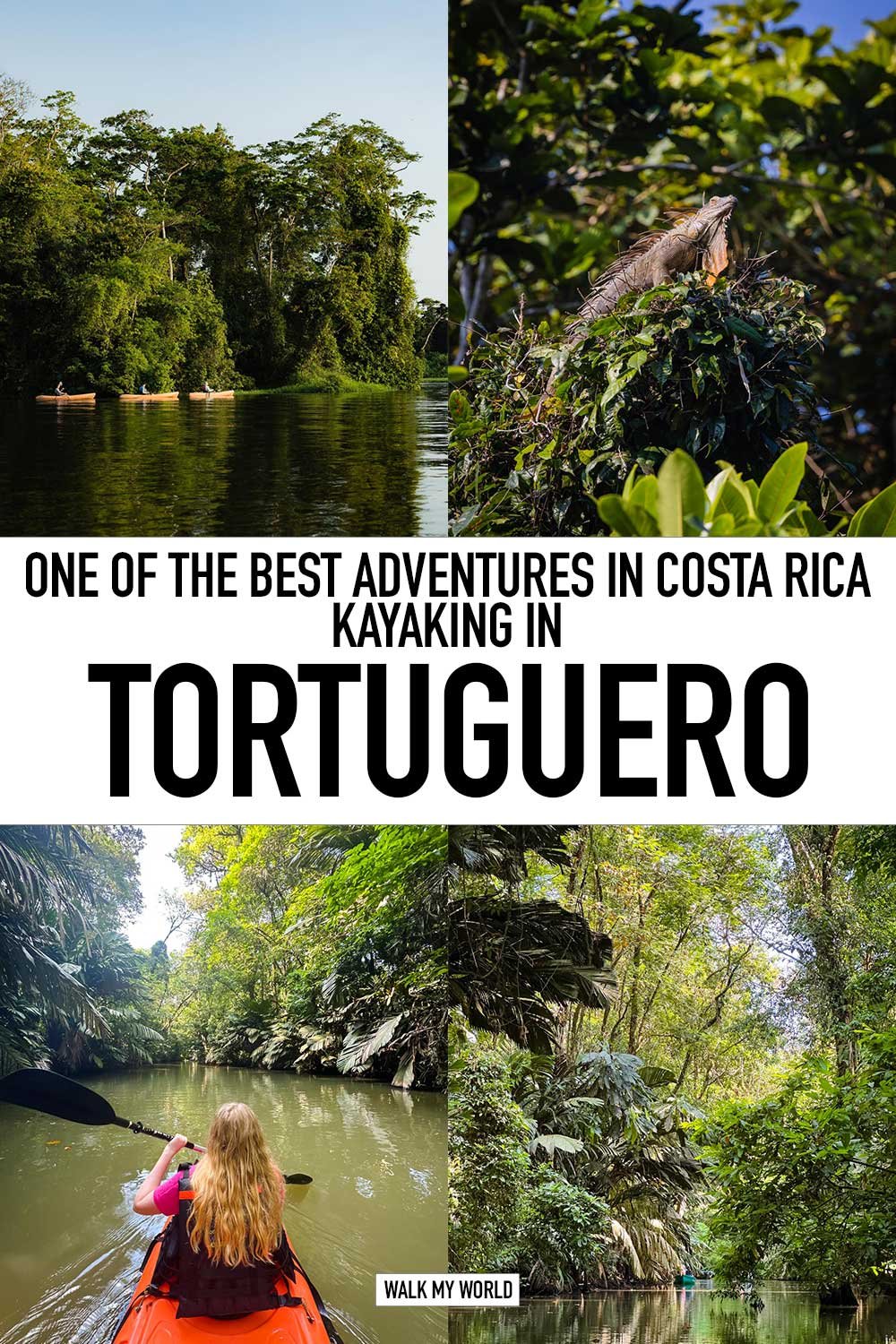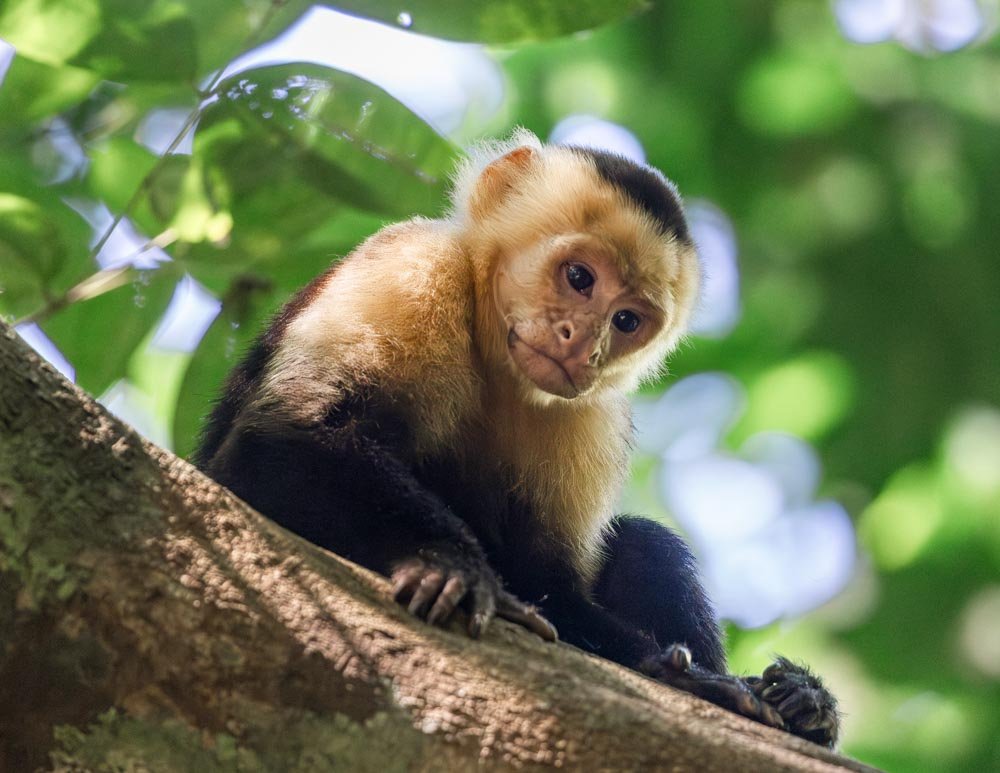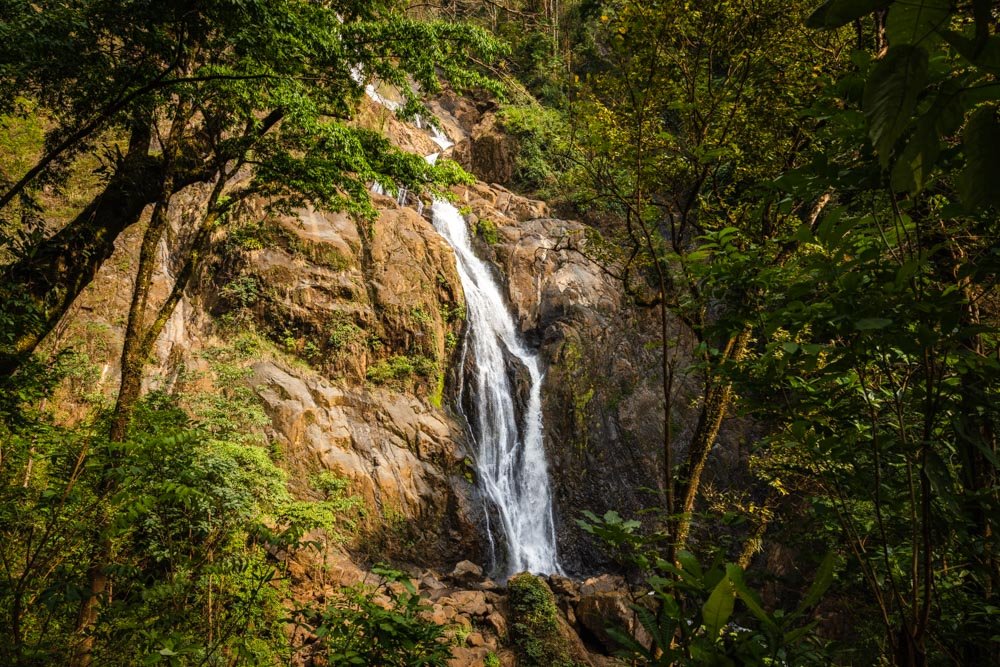As I write this, we’re coming to the end of our three month trip in Costa Rica. We’ve seen and done a lot of amazing things, and kayaking Tortuguero National Park was one of the best. Having done a guided canoe trip on a previous visit, this time we decided to be a little more adventurous and kayak the canals solo. It turned out to be an incredible experience; not only did we get to see so much wildlife, but we also got sections of the Jurassic Park-esque waterways to ourselves.
The whole experience was simply magical.
In this article, we’re going to share everything you need to know to canoe or kayak the park alone, and also how that compares to the experience with a guide.
Tips for canoeing or kayaking without a guide
1. Difficulty
The first thing to know about hiring your own canoe or kayak is that the water is calm and paddling is easy. It’s suitable for beginners and though you generally rent the boats for 3-3.5 hours, you can always go only for as long as your arms will manage.
On the way back we had a bit of a headwind which always makes it harder, but it still wasn’t difficult. Although there are motorboats, they tend to be small and don’t create too much in the way of wakes.
In terms of route finding, depending on where you hire you won’t be given any help at all (or maybe that’s just where we hired from!). On that note, we’re going to tell you the best route below, so you won’t miss out on the most special bits.
2. Early vs late
The hardest part about paddling yourself is the heat. For this reason we’d recommend heading out at the earliest time anyone will rent you a boat - for us this was 6am.
Although we didn’t speak to every rental company - so you may find one earlier - this was the earliest we could find. The alternative is to go later in the day, but I’d only do this on a really cloudy day - otherwise it can be quite brutal under the harsh afternoon sun.
During our visit the UV reading was 11, which is rated extreme. In the early morning the UV is low until about 8.30am (but do check in case it varies), so you can enjoy the paddle without having to cake yourself in sunscreen.
However, 6am is the most popular time to be out on the water and the vast majority of tours will be around. In the afternoon there’s virtually no one, so it does have its advantages.
3. Canoe vs kayak
Depending on when you visit, this decision may be taken out of your hands. For us, we were told we couldn’t rent a canoe until 2.30pm, as the canoes were required for guided tours. This left us with the choice of paddling late, or taking a kayak.
I don’t mind kayaking, but a canoe is more comfortable. The kayak we rented had no cushioning or back support and you can’t move around as much as you would in a canoe. However, if you are faced with the same choice as us, I’d still pick the early kayak every time.
4. Wildlife spotting
You will see wildlife without a guide, no doubt about it, but it will almost certainly be less than with a guide. However, the reward of finding the animals yourself does make it that little bit more special, at least in our opinion.
We saw Howler monkeys, Spider monkeys, caiman, huge iguanas, two types of toucan, Great green macaws, Jesus Christ lizards, two types of kingfisher, Northern jacanas, a Lineated woodpecker, egrets, and cormorants. We might have forgotten a couple, but we think that was it.
Is there more out there? Absolutely! And I saw more on my guided trip, but we were still thrilled with the amount we saw. I’ll give more tips on wildlife in the section about which route to take.
5. Time needed
Your average rental will be for between 3-3.5 hours. Personally we used our full allotted time and could have gone longer (well my enthusiasm could, but my bum was ready to get out). If you set off at 6am and use the full time, it will have already got steaming hot.
We didn’t have any cloud, so the sun was beating down harshly from around 8.30am. In the smaller tributaries you are shaded, but in the more open sections, it’s pretty unforgiving.
If you don’t want to go for so long, you could always give the kayak back early, so it’s really up to you on timing. I’d say you want two hours as a bare minimum, as it takes a good half an hour to get to the most beautiful bits (the narrow tributaries).
6. Cost and where to hire
We paid USD $20 per person for our kayak and we hired from the Guide Association by the main pier in the village. There are several other places along the main street hiring canoes and you could walk along the ‘strip’ and get prices from a few before deciding who to go with. We saw that the prices were a fair bit lower if renting in the afternoon, but as mentioned we were really keen to go first thing.
You’ll probably notice that this is not much cheaper than taking a guided trip (if you hire in the early morning), so the self guided option is not really about saving money, but about having your own adventure.
It’s best to arrange your rental the day before so you are guaranteed to have one waiting for you. It’s also worth noting that if you plan on doing more than one activity you can ask for a discount : )
The best route to take
From the pier you head left (south) and into the large open waterway. Even though this is the least picturesque part of the river, it’s worth having a little look around here as this is where we saw the most wildlife. It’s teeming with Howler monkeys and it’s also where we saw Spider monkeys, the toucans, Great green macaws, and woodpeckers.
The narrower tributaries had more of the lizards, iguanas, caiman and kingfishers. It’s also where I saw otters on my guided trip.
Once you’ve seen some animals in the open part of the river you want to head for the smaller tributaries. You don’t have to go far up river in the open section to see wildlife, so I wouldn’t waste too much energy paddling far. Stick to the edges and paddle slowly searching the forest canopy.
To find the smaller tributaries you want to be on the right side of the river (the western side) and looking for a right turn when the river is still wide.
You’ll see the river begin to narrow and at one point gets very narrow due to lots of plants in the water.
Then begin heading left and the further you go, the narrower it gets. We took the coordinates for our favourite section, Caño Harold, so if in doubt head towards these coordinates - 10.5255283, -83.5170395.
As mentioned it takes about 30 minutes to reach the best tributaries if going directly from the pier (although we timed it on the way back with a headwind, so you might go quicker).
You’ll also likely see other boats, so you’ll know you’re heading in the right direction. As the river narrows you’ll see tiny little side creeks, which canoes and kayaks can fit into. These are fun little crevices to explore and often hide some great wildlife, like caiman.
Once you reach our coordinates you’ll be gliding through an exquisite waterway, which felt like a true jungle adventure.
The emerald water, strangler figs, huge hanging vines and other dense foliage blocked all sun and gave the creek a mysterious feel. The beauty of hiring your own kayak is that the tours all turn from here at around 8.30am.
After this we had the whole creek to ourselves, we stopped paddling and just listened to all the incredible jungle sounds. It was this section of the river which put this experience in our top five in all of Costa Rica. I can honestly say it’s one of the best kayaking trips we’ve ever done.
It’s also where we saw tiny little kingfishers and huge green iguanas, as well as a variety of other lizards. But it would have been special without the wildlife because the setting was just so wild. To be here alone was unforgettable.
It did mean that we left the whole paddling back thing a bit late and had to go like speed demons to reach the pier in time, but it was worth it.
I think you could have the same experience in the afternoon as it’s so much quieter then, if you’re able to handle the heat.
Guided vs self guided trips
There are definitely pros and cons to both options, and it’s also worth noting I loved both! My guided trip was amazing and I saw a wealth of wildlife without having to do any of the hard work. There’s no doubt the guides will find more wildlife than you can, not only do they have a trained eye, but they know the common areas to find them.
Depending on the quality of the guide, they will also be able to tell you information about what you’re seeing. As the guided trips are USD $25 per person, there’s not much in it price-wise when compared to an early morning kayak rental. However, this is a group tour. Group tours tended to have a minimum of eight people and sometimes many more.
The tour I did was private and this was much more intimate, but now costs around USD $50 per person. These prices are based on going to the Guide Association at the pier, other operators prices will vary.
Personally, I would not take a motor boat trip because the sound of the motor ruins the tranquility, plus wildlife can hear you coming! Stick to the guided canoe trips for a more serene experience.
On a self guided trip you will see less wildlife and you may not know what you’re looking at. We’d been in Costa Rica over two months by the time we were in Tortuguero, so we knew quite a few animals. You have to put some physical effort into paddling, which is a pro or con depending on how you feel about that! According to our Applewatch we burnt 1,038 calories!
The major pro for self guided trips is the sense of adventure, the ability to go where you want, and to spot animals yourself. For us this was incredibly special.
If maximum wildlife spotting is the main appeal for you I would take a guide. If you have the time and budget doing both is very worthwhile, as they are very different experiences, and you could choose a different route to keep it interesting.
Whichever option you choose, it’s bound to be an incredible experience!
Where we stayed in Tortuguero
Casa Chilamates 2.0
There was a lot to like about Casa Chilamates 2.0, but also some faults. Firstly, it’s a little house with a kitchen, a good shower, very powerful AC and a jungle setting, yet just a five minute walk from town. It was perfectly quiet at night apart from the sounds of the insects, which I personally love.
However, the curtains are very thin and the surrounding houses leave their porch lights on all night. If light bothers you, do not stay here. Also the AC unit is powerful, but very noisy and had a bright light which couldn’t be turned off. Personally I didn’t like these two things, but I am very sensitive when it comes to sleeping - not one previous reviewer had mentioned these points, so I guess I am alone in this!
If you don’t mind the light and AC noise, then you’re surrounded by Great green macaws and Howler monkeys in the nearby trees, which is very special.
You can check out more reviews and the prices on:
Mawamba Lodge
Due to the aforementioned sleeping issues, If I am lucky enough to return to Tortuguero for a third time I would stay at Mawamba Lodge. We actually walked past it on our night walk and it looked great. It was in a quiet location a bit away from town but if you don’t want to walk in, I believe you can catch the boat.
The rooms look lovely and each window is netted so you get the full breeze which is why I’d pick it as Tortuguero was insanely hot (although we were visiting in a rare patch with no rain!). They also have hammocks on the porch and there’s a pool.
You can check the reviews and prices on:
This post may contain affiliate links, meaning at no additional cost to you, we will earn a small commission if you click through and decide to make a purchase. This helps towards the costs of running our website. Thanks for your support.



















































